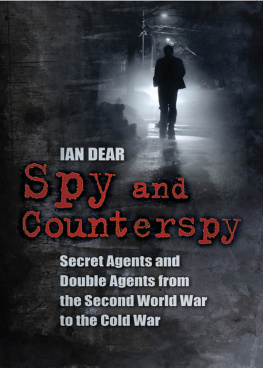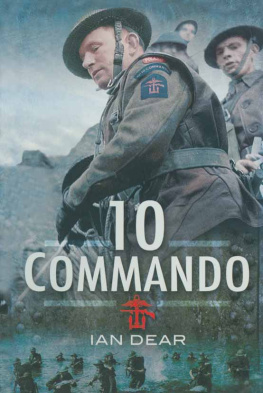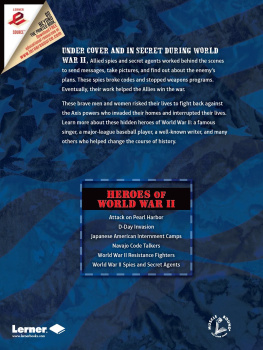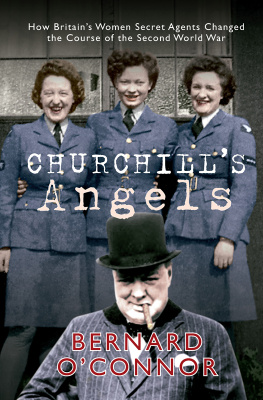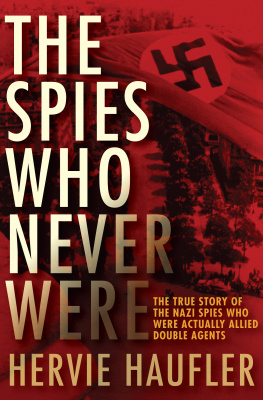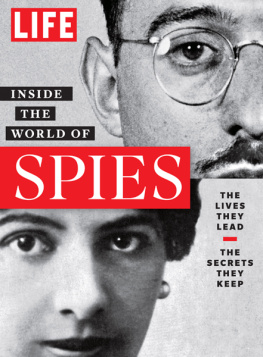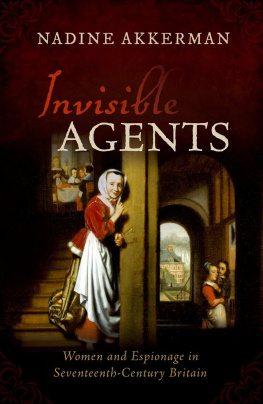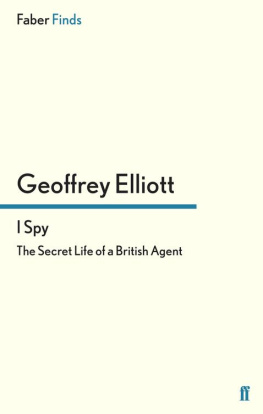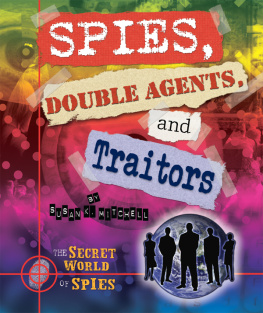Contents
I would like to thank the following for permission to use extracts from the titles listed below. Other copyright holders have been credited in the chapter notes:
Miranda Carter, Anthony Blunt: His Lives (London, 2001). Copyright Miranda Carter, 2001. Published by Macmillan, 2001
Ewen Montagu, Beyond Top Secret Ultra (London, 1977). Extracts reprinted by permission of the Random House Group Ltd, and by the Penguin Group (USA) Inc
Kathryn S. Olmsted, Red Spy Queen: A Biography of Elizabeth Bentley (Chapel Hill, NC, 2002). Copyright the University of North Carolina Press, 2002, www.uncpress.unc.edu
Russell Miller, Codename Tricycle: The True Story of the Second World Wars Most Extraordinary Double Agent (London 2005). Reprinted by permission of The Random House Group Ltd and Peters Fraser & Dunlop (www.petersfraserdunlop.com) on behalf of Russell Miller
Yuri Modin, My Five Cambridge Friends (New York, 1994). Copyright Editions Robert Laffont S.A. Paris, 1994. Extracts reproduced by permission of the publisher, Headline Publishing Group Ltd and by Farrar Straus & Giroux, New York
Quotes from articles in Journal of Intelligence and National Security and International Journal of Intelligence and Counter-Intelligence. Reprinted by permission of the publisher (Taylor & Francis Ltd, http://www.tandf.co.uk/journals)
While every effort has been made to contact the copyright holders of all the titles from which I have used extracts, I have not always been successful. These copyright holders are invited to contact the publishers, as are those copyright holders of the photographs I have been unable to trace.
| A-A | Anti-Aircraft |
| ASIO | Australian Security Intelligence Organisation |
| BBC | British Broadcasting Corporation |
| CIA | Central Intelligence Agency |
| COI | Office of Coordination of Information |
| CPGB | Communist Party of Great Britain |
| CPUSA | Communist Party of the United States of America |
| DAK | Deutsches Afrika Korps |
| DNB | Deutsches Nachtrichten Bro |
| FBI | Federal Bureau of Investigation |
| FO | Foreign Office |
| FUSAG | First United States Army Group |
| GC&CS | Government Code and Cipher School |
| GCHQ | Government Communications Headquarters |
| GRU | Glavnoye Razvedyvatelnoyed Upravleniye: Soviet Military Intelligence |
| IRA | Irish Republican Army |
| IRD | Information Research Department |
| ISOS | Intelligence Services Oliver Strachey |
| JCS | Joint Chiefs of Staff |
| KGB | Komitet Gosudarstvennoi Bezopastnosti: Soviet Security and Intelligence Service (195491) |
| LRDG | Long Range Desert Group |
| MBE | Member of the British Empire |
| MGB | Ministerstvo Gosudarstvennoi Bezopastnosti: Soviet Ministry of State Security (194654) |
| MI5 | British Security Service |
| MI6 | British Secret Intelligence Service |
| MP | Member of Parliament |
| NKGB | Narodnyi Kommissariat Gosudarstvennoi Bezopastnosti: Soviet Security and Intelligence Service (194146, part of NKVD 194143) |
| NKVD | Narodnyi Kommissariat Vnutrennikh Del: Peoples Commissariat for Internal Affairs (192223, 193443) |
| OBE | Order of the British Empire |
| OGPU | Obyedinennoye Gosudarstvennoye Politicheskoye Upravleniye: Soviet Security and Intelligence Service (192334) |
| OKW | Oberkommando der Wehrmacht |
| OSS | Office of Strategic Services |
| POW | prisoners of war |
| RNVR | Royal Naval Volunteer Reserve |
| RSHA | Reichssicherheitshauptamt: Reich Security Main Office, the Nazi Partys umbrella organisation for all its security services |
| SD | Sicherheitsdienst: Nazi Intelligence Service |
| SIME | Security Intelligence Middle East |
| SOE | Special Operations Executive |
| SSA | Signals Security Agency |
| USSR | Union of Soviet Socialist Republics |
This is the final part of a trilogy on clandestine warfare. Like the first two Sabotage and Subversion and Escape and Evasion this book covers events during the Second World War, but it also includes the decades on either side of it. Espionage is often a very long-term business, and it would be no use confining the work of The Cambridge Five, for instance, to the war years when they did as much, if not more, damage to the interests of their country in peacetime. However, the main focus is on the years 193945, and the examples I have chosen are but a small cross-section of the espionage both sides employed even when the countries concerned were supposed to be Allies.
It is commonly acknowledged that more lies have been told about spies and spying than any other subject. A possible exception is sex, and it is not a coincidence that the two subjects are linked by that doubtful distinction. Perhaps someone some day will write on the love life of spies and how it motivated their behaviour. However, the examples of espionage I have chosen are not for any prurient motive, but because more information has become available about each of them. The sources include a short-lived partial access to the KGB archives during the early 1990s; the posting by the United States National Security Agency of the VENONA signals and related material on the internet during the mid-1990s; and the release into The National Archives at Kew of MI5 and associated files which is still ongoing. The publication of the official histories of MI5 and MI6, in 2009 and 2010 respectively, and the release of certain private diaries and memoirs during the last decade, have also helped me, I hope, edge slightly closer to the truth.
So the fog surrounding espionage during the Second World War is becoming a little less dense. For example, it is now acknowledged that some early post-war tales of espionage were not much more than cover stories for ULTRA intelligence. This is not to belittle the courage of the agent concerned, but shows the extent to which the authorities went to keep ULTRA a secret until it was eventually became public knowledge in the 1970s.
Will the fog ever clear completely? Not a hope. Spying by its very nature is all smoke and mirrors, which is why it remains a subject of such fascination to so many.
Ian Dear
Cottenham, Cambridge, January 2013
1
Pit and Pan and the
English Patient
In May 1942 German Military Intelligence (Abwehr) mounted SALAM, the codename for an operation to infiltrate two of its spies across the desert from Axis-held Libya into Egypt. Once this was accomplished, the spies were to implement operation CONDOR, which was to discover British plans to prevent German and Italian forces from capturing the Suez Canal, Britains lifeline to its Far East Empire. They were also ordered to encourage an incipient Egyptian Army plot to revolt against the British.
Erwin Rommel, the charismatic German general commanding the Axis armies in Libya, already had an excellent, if unwitting, intelligence source in the American military attach in Cairo, Colonel Fellers. The role of Fellers was to report to Washington on what the British were up to militarily and diplomatically. This he did meticulously, not knowing that the diplomatic cipher (the Black Code) he used to relay his reports was being read by the Italians who had acquired photographs of the codes enciphering tables from the US embassy in Rome.

